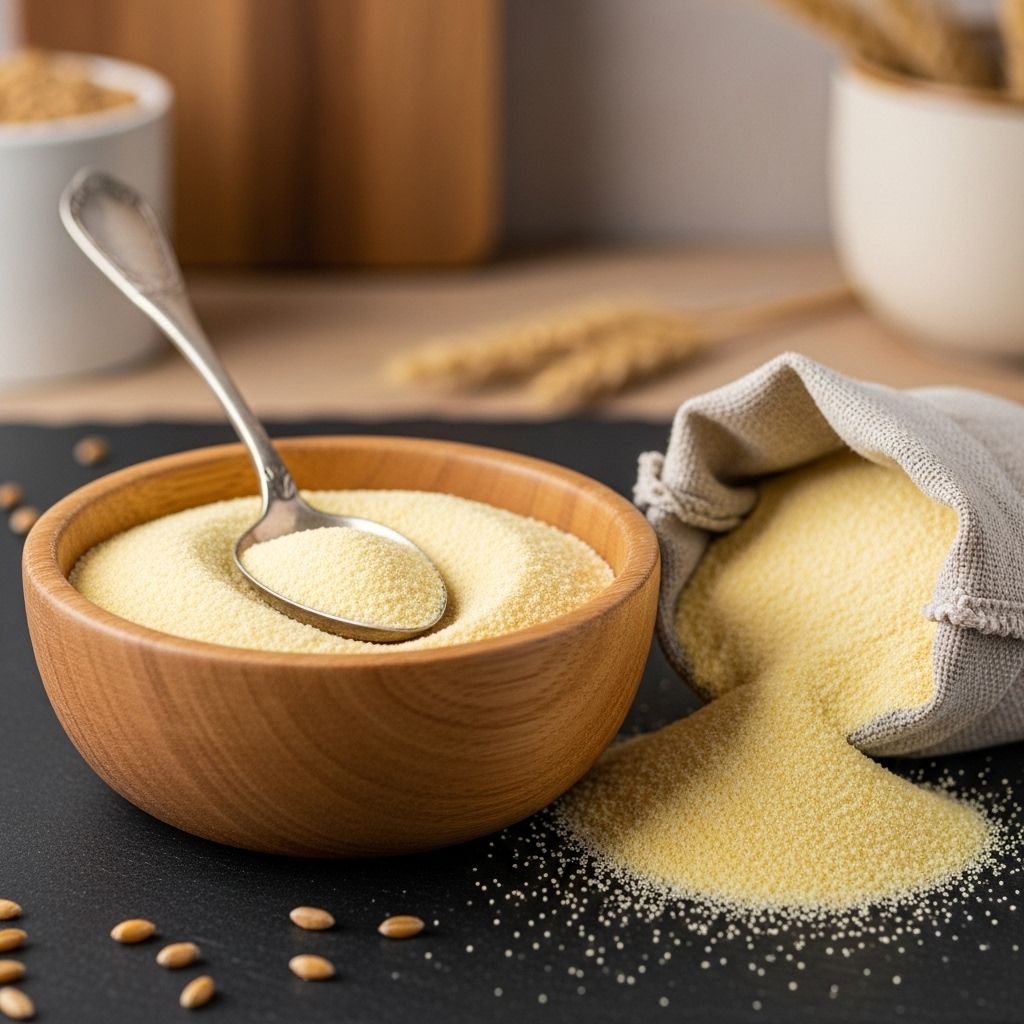Semolina: Unveiling Its Benefits, Uses, and Taste
Explore the authentic flavor and texture that elevate dishes from pasta to pudding.

What Is Semolina?
Semolina is a coarse flour made from durum wheat, known for its high protein and gluten content. This characteristic makes it particularly suitable for producing pasta and various types of bread. Semolina is distinguished by its coarse texture and pale yellow color, which results from the milling process of durum wheat.
The word “semolina” originates from the Latin term simila, meaning “fine flour,” with the diminutive suffix -ino added to form semolino. This term eventually evolved into “semolina” in English.
Production Process of Semolina
The production of semolina involves a specific milling process that separates the endosperm from the bran and germ of durum wheat. The process employs grooved steel rollers to flake off the bran and germ while cracking the starch into coarse pieces. These pieces are then sifted to produce semolina, which is further ground into flour. This method allows for different grades of flour, as the inner parts of the endosperm tend to break down into smaller pieces than the outer parts.
Key Differences Between Semolina and Other Flours
Semolina is distinct from other wheat flours due to its coarse texture and high gluten content. In contrast to all-purpose flour, which has a neutral flavor and average protein content, semolina offers a nutty flavor and is more robust in texture. While all-purpose flour is versatile, semolina’s unique properties make it ideal for specific culinary applications like pasta and couscous.
Benefits of Semolina
Semolina is rich in nutrients, including protein, fiber, and B vitamins. These nutritional benefits support weight management, heart health, and digestive health. The high gluten content in semolina also contributes to its elasticity, making it suitable for kneading and shaping into various pasta forms.
Nutritional Composition
A significant benefit of semolina is its nutritional profile. It contains a good amount of protein and fiber, which can aid in digestion and satiety. Additionally, semolina is a source of B vitamins, which are essential for energy production and maintaining healthy skin and hair.
Uses of Semolina
Semolina is a versatile ingredient used in several culinary applications:
- Pasta: Semolina is the primary flour used in making pasta due to its high gluten content, which gives pasta its chewy texture.
- Couscous: Made from semolina flour, couscous is a staple in North African cuisine, often served with vegetables and meats.
- Bread: Coarse semolina flour is used to make bread, providing a nutty flavor and texture.
- Sweet Dishes: Semolina is also used in desserts like semolina pudding, which is popular in many parts of the world.
Substitutes for Semolina
For those looking to substitute semolina in recipes, cornmeal is a common alternative due to its similar texture. However, all-purpose flour can be used as a substitute in some recipes, although it may not provide the same texture and flavor as semolina.
The Taste of Semolina
Semolina flour has a slightly nutty and sweet taste, with a coarse texture similar to cornmeal. This distinctive flavor enhances the dishes it is used in, making it a favorite among chefs and home cooks alike.
Frequently Asked Questions (FAQs)
Q: What is semolina made from?
A: Semolina is made from durum wheat, which is the hardest species of wheat and has a high protein and gluten content.
Q: What are the primary uses of semolina?
A: Semolina is primarily used for making pasta, couscous, and bread. It is also used in desserts like semolina pudding.
Q: Does semolina have nutritional benefits?
A: Yes, semolina is rich in protein, fiber, and B vitamins, supporting weight management, heart health, and digestion.
Q: Can semolina be substituted with other flours?
A: While semolina can be substituted with cornmeal or all-purpose flour in some recipes, the texture and flavor may differ. Cornmeal provides a similar texture, but all-purpose flour lacks semolina’s nutty taste and coarse texture.
References
- https://en.wikipedia.org/wiki/Semolina
- https://www.webstaurantstore.com/blog/2924/semolina-flour.html
- https://unocasa.com/blogs/tips/what-is-semolina
- https://www.healthline.com/nutrition/semolina
- https://www.merriam-webster.com/dictionary/semolina
- https://www.kingarthurbaking.com/blog/2023/06/20/what-is-semolina-flour-and-how-do-i-bake-with-it
- https://pastafresh.com/blog/semolina-flour-the-perfect-choice-for-extruded-pasta
Read full bio of Sneha Tete












